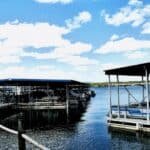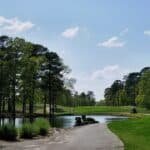At the February 2, 2022, Discussion Session, Common Property, Forestry, and Wildlife (CPF&W) Manager, Todd Noles, explained that Anne Shears, Secretary of the CPF&W Committee created an IPS Beetle PowerPoint presentation. Noles stated that the committee is very instrumental in assisting in the work that he does and they are greatly appreciated. Noles enthused, “it’s a great representation of the Property Owners helping staff and using some of their knowledge. I have retired foresters [on the committee]. Noles introduced Max Billingsley, Chair of the CPF&W Committee, and Committee Secretary, Anne Shears.
Billingsley: We have IPS beetles in the stand located by Elcano on the north side of DeSoto Boulevard beginning on the west side of Elcano Drive and ending at Isabella Golf Course, just east of Iniciador. Click here to read the previous article about the tree thinning project being conducted in that area in order to remediate the IPS beetle infestation.
Billingsley: “A few surprises came along and they are good surprises.”
Billingsley: One, is that Todd was able to find a logging/harvesting operation that had light duty equipment – nothing more than a farm tractor with a grapple and a blade that is not as heavy as some of the big logging equipment.” Using this equipment helps to prevent a lot of damage to the ground and remaining trees.
Billingsley: The second surprise is that we are able to sell some of the dead trees for pulpwood, which is used to make paper. “I never thought we’d be able to sell dead timber.”
Billingsley: “As a forester, I am pleased to see the operation going as smoothly as it is.” The area has a large overstock of trees. “This is a 32-year-old stand that has had nothing done to it. So it is thinning itself. You can see the trees that have died and even fallen down. That is timber that has been lost that could have been salvaged and sold. But now it is just rotten logs.”
Billingsley: On some of the trees, all of the foliage is gone and the bark is starting to scale off of the stems.” Some of these trees are marketable and some are too far gone – we’re going to have to cut them down and leave them.”
Billingsley: This stand contains numerous areas where there are boreholes from the IPS Beetles.
Billingsley: There are three species of IPS Beetles. One species attacks the lower trunk. One species assaults the middle part of the tree. The third species strikes the crown of the tree. All three species have infested this stand.
Billingsley: “As the IPS Beetles bore into the tree they create a fine sawdust known as frask, at the bottom of the tree, which is a sign that they are active.”
Billingsley: This IPS Beetle infestation is in a very visible area, close to the East Gate. We are being careful to make sure that this operation goes smoothly and with as little mess as possible.
Board Director, Gary Belair: “Have you and Todd identified other areas that are already infested like this?”
Billingsley: We have not examined all of the areas, but I am sure Todd is involved in doing that.

Noles: “Yes, sir. We found another area that we are going to be looking at that is not far from there. It is just a little bit west of Elcano. The most activity we’ve seen is towards the east end where the Plantation Pines are thick. That is the most IPS activity that we’ve seen. You’ve got a few up towards the west end…” The trees seeded themselves and have not been thinned for over 30 years. It is a very overgrown area and that is causing stress to the trees, which causes the IPS Beetles to attack.
Board Director, Pam Avila: “I live on the west end and trees there are pretty thick. And you are saying that it is important that sunlight be able to get down in. Do we have any plans for going through the Village and seeing what areas need thinning?”
Noles: Yes, ma’am. What I am trying to do now – we have a GIS system and I am working with a timber company to get all of our timber mapped into the system. We’ll be able to look on the computer and tell what stands we have; how thick it is; the species of timber we have in each stand; and if we have any diseases in there.” This will be accomplished using satellite imagery.
Noles: We can get a plan together. We haven’t thinned since – I believe Bruce Caverly was involved in the last thinning.” Noles said it has been several years since this occurred.
Bruce Caverly: “We started in 2008 and we ran for 12 years doing about 130 subdivisions throughout the Village.”
Noles: This is being done to maintain a healthy forest more so than for the revenue. Additionally, when the trees become diseased and fall over, they can hit nearby homes.
Billingsley: These infestations can occur, not only on the common property on the east end in these areas where there’s a lot of Plantation Pine, but also on undeveloped overstocked lots. Property Owners are going to start to have issues or may already have issues on some of those lots with the insect infestation. When we go into common property like that, Todd talks to every one of the surrounding owners of the occupied lots. There are several undeveloped lots that have serious issues.
Board Director, Bob McLeod: “The cost of all this – is the revenue enough to cover the cost of doing this?”
Noles: On average, you get three truckloads [timber] per acre. That’s 25 tons per truckload. That is 75 tons of timber from these three acres. It depends on the size of the timber…In the stand where we are currently working, we’ve gotten more and larger timber than I expected. We’re going to probably end up, making about $1,000. What I am trying to do now is to sell the timber to pay for the cleanup…”We’re trying to make what revenue we get off of this to pay for the cleanup.”
McLeod: “Is it going to cost us money for you to do all this everywhere or is it going to be revenue-producing?”
Noles: “It is all revenue. It doesn’t cost the POA anything. What I do is usually sell the timber. In the past, we sold the timber, but they left the slash.” We will be cleaning up the old slash.
Board Chair, Joanie Corry: “These beetles were in this section on Elcano. Do they migrate to fresher trees at some point or are they kind of just caught in that one section there? My question is if we have several lots that people own and they have these beetles, would they migrate to the common properties? In other words, I am looking at lots that people own that might possibly have this infestation. What do we do about those? Or we can’t do anything about those? Right?”
Noles: “We can’t do anything about those. For example, on Victoria Lane, there is a gentleman that lives there with an undeveloped lot adjacent to his home.” When talking to each individual Property Owner to let them know what we were planning to do and what to expect, I informed this gentleman that he has a bad IPS infestation on his undeveloped lot. I explained to him that while our loggers are there, if he wants us to, we can also thin his trees.” He was agreeable. With his permission, we are doing the same process on his lot.
Noles: The IPS beetles can spread by wind. They only attack stressed pine trees. When utility companies disturb the roots, it can cause trees to become stressed.
✺ ✺ ✺ ✺ ✺
IPS Beetle Infestation of Plantation Pines in Hot Springs Village PowerPoint Presentation Created by Anne Shears
IPS-Beetle-Presentation-by-CPFW-Committee-to-Board-on-2-2-22✺ ✺ ✺ ✺ ✺
Much appreciation to the CPF&W Committee Members, Max Billingsley, Tom Impellizzeri, Anne Shears, Paula Lane, Scott McCord, Barton Langford, and Board Member Liaison, Tucker Omohundro and Manager Todd Noles for their continued and dedicated service in helping to keep our forest in the most beautiful place in the world healthy and attractive.
✺ ✺ ✺ ✺ ✺
Thank you for reading. If you like, please comment below; we love to hear your opinion. Thank you for keeping the comments polite and on topic. Please use your real name. If you are an HSV Property Owner, please join us in our private Facebook Group. Click here to join the group. If you would like to submit an article for publication, please contact us through this website. Be sure to bookmark this website.












Carolyn Haney
02/05/2022 — 9:06 am
I have a dead pine tree on my easement. Is that tree my responsiblity to get it cut down or the POA? Are all the neighborhoods in the Village going to be checked for the investation?
Anne Shears
02/05/2022 — 10:05 am
If the tree in the easement is on your side of the property line, then the tree is your responsibility. If it is on the other side of the property line on the easement, then it would be the responsibility of the owner of the lot on that side. If that lot is owned by the POA, then the POA would be responsible. If the lot next door is owned by a non-resident, one would need to get the contact info from the POA and send a REGISTERED letter (with green post card) advising the owner of the hazardous condition. The green post card will be returned to you and proves that the owner has been put on notice. This is for insurance reasons so that your insurance company can take care of your situation and file a claim against the other property owner. As for the second question: That would be a good discussion item at Monday’s meeting (1:30 PM at PTEC)
Patty MacDonald
02/05/2022 — 8:15 pm
My understanding is that CCI has some ownership rights on the utility easements between houses. Is that correct? Please clarify those rights. If a large pine tree is located on the property line and is leaning toward one of the houses , does CCI incurr the cost of removing it?
Anne Shears
02/06/2022 — 7:37 am
Those utility easements were put in place to give the utilities a place to run their cables, pipes, etc. If those buried utilities require repair, the utility company has the right to dig there and effect the repair.
When you build a fence on the property line, that fence is within the easement and utility companies can knock it down in order to dig. The utility will NOT repair the fence. That is the financial responsibility of the property owner. CCI has no obligation to property owners in this regard.